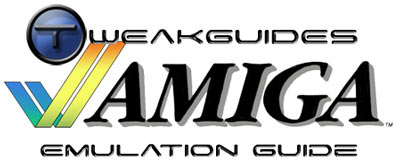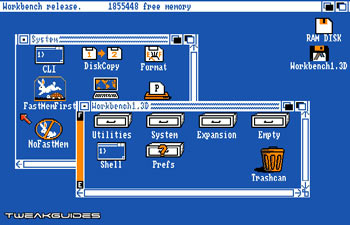Amiga Emulation Guide
Author: Koroush Ghazi
Last Modified: May 2011
Introduction
This guide provides details on how to get an Amiga emulator up and running on your PC. The guide is a tribute to the Commodore Amiga 500 – my first real "personal computer", and the beginning of what was to become my deep interest in all things computer-related. As such, I hope you excuse the somewhat nostalgic aspects of this guide, as well as my focus on the emulation of the Amiga 500 above all other Amigas.
The original Amiga (the Amiga 1000) arrived in 1985, and although I'd heard about it and seen it in computer stores, it wasn't until the Amiga 500 came out in 1987 that my parents considered buying one. By that time I had friends who owned IBM, Macintosh and even ageing Commodore 64 computers, and I felt a bit left out. I was jealous of my friends who could play seemingly endless varieties of amazing games on their Commodore 64s, or who had this incredible thing called a "mouse" for their Macintosh which made using even word processing programs look like fun.

So with a lot of cajoling, prompting and nagging about how the Amiga was a cheap way of helping me study better and how everyone else had a computer, I managed to convince my parents to buy one in late 1987. I was 16 years old at the time, and I remember vividly the day I brought home and unpacked my new Amiga 500, complete with monitor, mouse and a copy of Roadwar 2000. I spent the best part of the next 7 hours setting up and playing my new Amiga. That was the start of my fascination with computers and also the beginnings of my interest in tweaking.
For those of you who haven't seen or used an Amiga before, you may be wondering why this machine is still talked about to this day. There are several reasons, but the main one is the fact that it was the first real affordable multimedia PC/Console. It had genuinely amazing graphics and sound, and a mouse and Windows-like AmigaOS interface which was leading edge back in the mid 80's. Furthermore, game developers could use its advanced multimedia features to produce incredible games which made those you could play on other machines and even commercial arcade machines seem silly in comparison.
On top of all this, the Amiga inspired some phenomenal efforts from the demoscene which are still cool when viewed today. Cracking groups at the time – the forerunners of today's major warez groups – programmed some incredibly tight intros to cracked games which used tiny amounts of space, loaded in virtually no time, and provided graphics and music which sometimes shamed the game that would load afterward!
The Amiga 500 was a great entry point into computing in the late 80's for people like me who couldn't justify the cost of a "serious" PC. The Amiga 500, much like the Commodore 64 before it, was the platform of choice for budding programmers and enthusiasts, and this Amiga Emulation guide is my homage to the mighty Amiga 500. Using the software and tips in this guide, you should be able to get an almost-perfect emulation of an Amiga 500 on your PC. Everything from the famous "hand-holding-the-disk" loadup screen, to the drive loading sounds, through to how to download and play (free legal) games like Defender of the Crown or R-Type. Even if you've never used an Amiga before, come and see the nostalgic 80's in all their glory, and marvel at how advanced stone-age computers actually were!
Note: This guide contains advice specifically on how to emulate the Amiga 500 computer and the AmigaOS 1.3 environment on a Windows PC. However you can emulate other Amiga PCs and AmigaOS versions using the same software and techniques.

